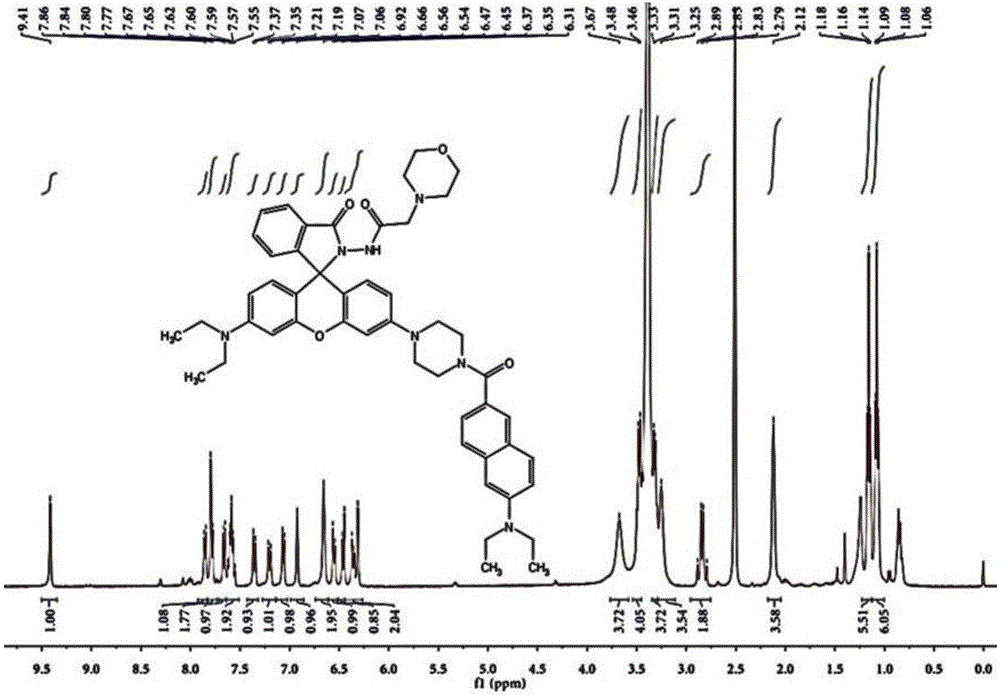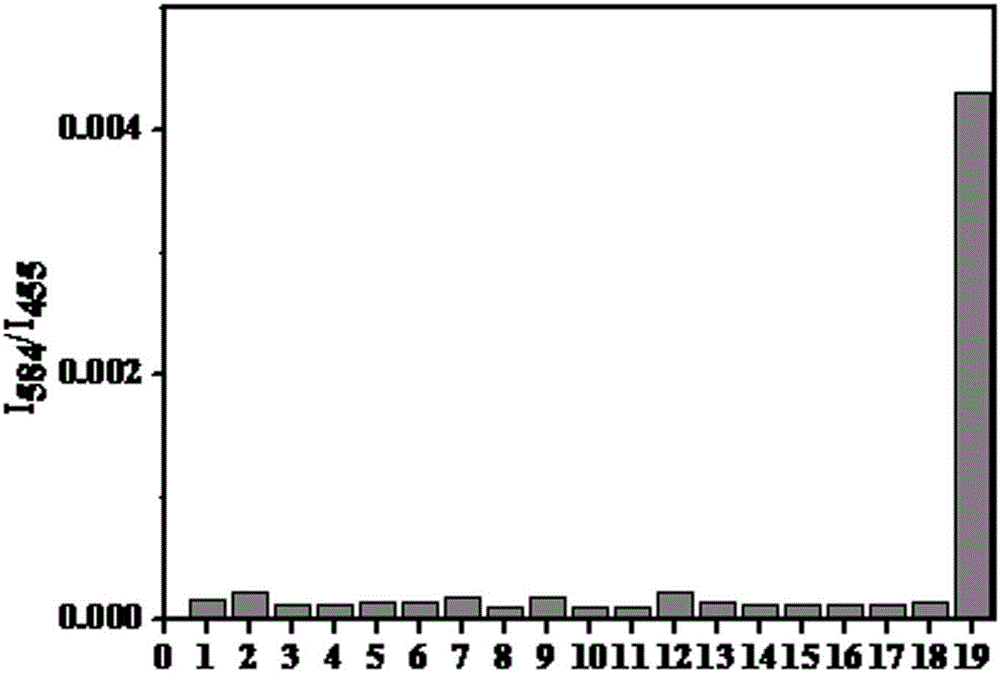Ratiometric fluorescence probe for target hypochlorous acid in lysosome, method for preparing ratiometric fluorescence probe and application thereof
A technology of ratiometric fluorescent probes and fluorescent probes, applied in the field of analytical chemistry, can solve problems such as the lack of ratiometric probes, the concentration of probes, the influence of detection temperature response time recognition, etc., to achieve simple post-processing and anti-interference from other molecules The effect of strong ability and low synthesis cost
- Summary
- Abstract
- Description
- Claims
- Application Information
AI Technical Summary
Problems solved by technology
Method used
Image
Examples
Embodiment 1
[0034] Synthesis of Compound Lyso-HClO Hypochlorous Acid Fluorescent Probe
[0035] Synthesis of Compound 1:
[0036]
[0037] 4-Diethylamino ketoacid (10mmol, 3g) and m-hydroxyphenylpiperazine (10mmol, 1.77g) were dissolved in 3ml of concentrated sulfuric acid, heated at 90°C for 3h, cooled to room temperature, and 4ml of perchloric acid was added under ice bath , the crude product was obtained, separated by column chromatography, the silica gel particle size was 200-300 mesh, the eluent ratio was dichloromethane / methanol=20:1, and the yield was 80%.
[0038] Synthesis of Compound 2:
[0039]
[0040]Compound 1 (2.5g, 5mmol, 1eq) was dissolved in 20mL of ethanol, 5ml of 80% hydrazine hydrate was added dropwise and heated to reflux for 3h, and the reaction was detected with a TCL plate. Silica gel column for separation, the size of silica gel particles is 200-300 mesh, the ratio of eluent is dichloromethane / methanol=20:1, and the yield is 85%.
[0041] Synthesis of co...
Embodiment 2
[0051] Changes of Fluorescence Spectrum of Compound Lyso-HClO Hypochlorous Acid Fluorescent Probe with the Increase of NaClO Equivalent
[0052] The Lyso-HClO hypochlorous acid fluorescent probe prepared in Example 1 was dissolved in N,N-dimethylformamide (DMF) to prepare a 1 mmol / L stock solution. Take 40μL from the stock solution and add it to a 5mL centrifuge tube, dilute to 4mL with PBS buffer solution (0.1mol / L, pH=7.4) and DMF with a volume ratio of 1:1, and add different equivalents (0-12eq) The NaClO standard solution was used to measure its fluorescence properties. Fluorescence spectra such as figure 2 shown. The left picture shows that the fluorescence intensity of the fluorescent probe gradually weakens (455nm) with the increase of NaClO addition equivalent under the excitation wavelength (380nm), and the right picture shows the fluorescence probe under the excitation wavelength (500nm) condition with NaClO addition With the increase of the equivalent, the fluor...
Embodiment 3
[0054] The Selectivity of Compound Lyso-HClO Hypochlorous Acid Fluorescent Probe to Different Molecules or Ions
[0055] Take 30 μL from the fluorescent probe stock solution in Example 2 and add it to a 5mL centrifuge tube, add an equimolar amount of competing molecule standard solution, one of which adds an equimolar amount of hypochlorous acid standard solution [(1) blank; (2)t-butylhydroperoxide; (3)H 2 o 2 ; (4) NO; (5) peroxide tert-butyl ether; (6) OH — ; (7) NO 2 — ; (8) NO 3 2— ; (9) I — ;(10)S 2— (11) Cys; (12) GHS; (13) Hcy; (14) Cu 2+ ;(15);Co 2+ (16)Ca 2+ ;(17)Mg 2+ ;(18)K + ,(19)OCl — ], with PBS:DMF (1:1) as solvent after 30min, 365nm is excitation light, detects the fluorescence emission spectrum change of solution, the result is as follows image 3 shown. At the same time, the influence of other metal ions on the fluorescence intensity of the probe of the present invention was studied, using PBS:DMF (1:1) as the solvent and 380nm as the excitatio...
PUM
 Login to View More
Login to View More Abstract
Description
Claims
Application Information
 Login to View More
Login to View More - R&D
- Intellectual Property
- Life Sciences
- Materials
- Tech Scout
- Unparalleled Data Quality
- Higher Quality Content
- 60% Fewer Hallucinations
Browse by: Latest US Patents, China's latest patents, Technical Efficacy Thesaurus, Application Domain, Technology Topic, Popular Technical Reports.
© 2025 PatSnap. All rights reserved.Legal|Privacy policy|Modern Slavery Act Transparency Statement|Sitemap|About US| Contact US: help@patsnap.com



